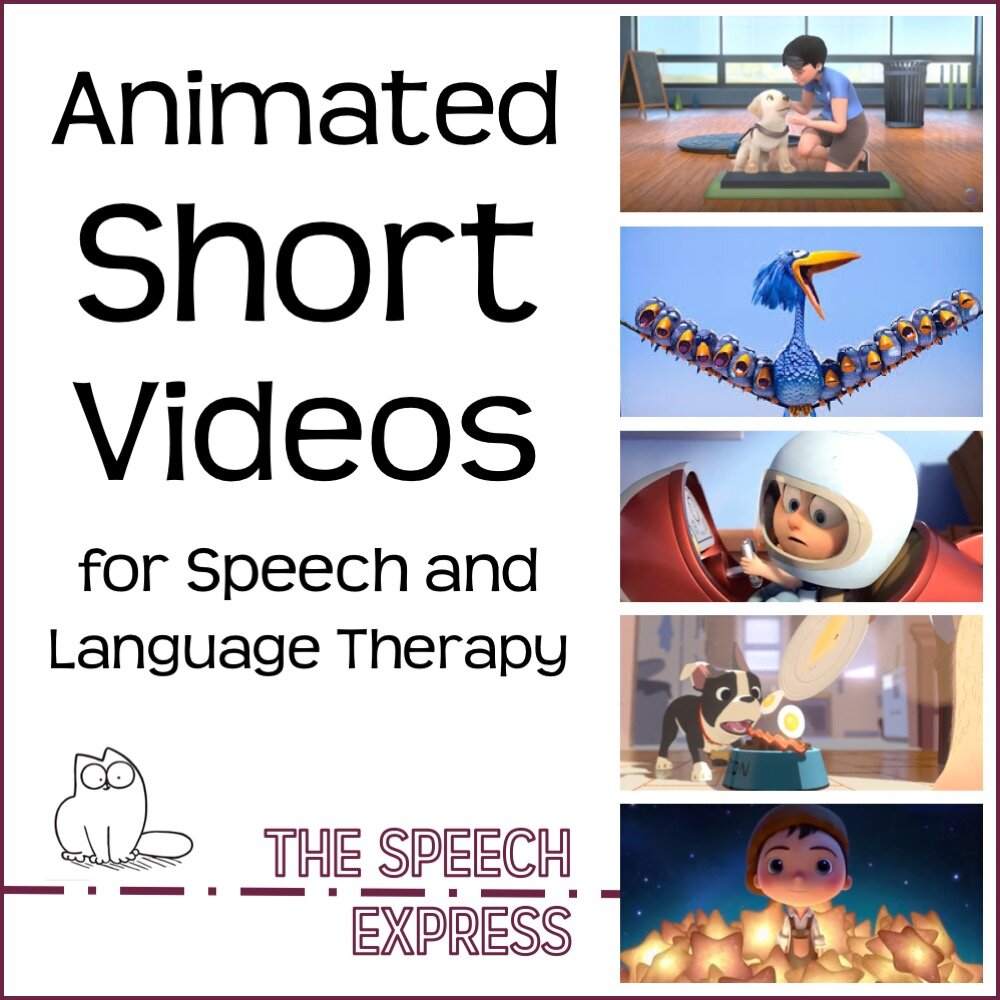Animated Short Videos for Speech and Language Therapy
Watching short, animated videos is an excellent way to work on a variety of speech and language skills while simultaneously keeping students engaged and motivated. Some ways these videos can be used to target goals include…
Main Idea
After watching the video, students can identify the main idea, or the central point of the story. It can typically be stated in one sentence. In order to figure out the main idea, students should answer the question, “What point is this movie trying to make?”
Summarizing
In order to summarize the movie, the students must identify the characters, setting (when and where the movie takes place), and the sequence of events. It also includes identification of the problem and how that problem was solved. When summarizing the movie, encourage students to use transition words, such as ‘first, next, then, last’ etc.
Predicting
While watching, frequently pause the video whenever a character is about to make a decision or a problem is introduced. Have students make a prediction about what might happen next using the phrase, “I predict ______ because ______.”
Problem-Solving
Watch the video and identify the problem and the solution. Then, discuss other ways the problem could have been solved as well as the pros and cons of each solution. Then, have students determine which solution they would have chosen and explain why that would be the best choice.
Grammar/Sentence Structures
Periodically pause the video and have students create a sentence about what they’ve watched by using a coordinating conjunction (and, or, but, so, etc.) or subordinating conjunction (although, until, unless, if, etc.). Another option is to have students come up with each of the following sentence types: declarative (statement), interrogative (question), exclamatory (exclamation!), and imperative (demand).
Making Inferences
Ask questions about the movie that require the student to make an inference or take an educated guess. In order to make inferences, students use what they see and what they already know (background knowledge) as evidence for their answer. Inferential questions typically begin with ‘why’ or ‘do you think?’ and the answer cannot be directly stated or observed in the movie. For example, if the video were to show a boy hobbling inside, putting down his skateboard, and asking for a band-aid, an inferential question could be, “Why does the boy want a band-aid?”
Articulation
For students who are practicing their sounds at the word level, go on an articulation word hunt! Whenever students see an object in the video that contains their sound, they should write it down. If working with a group of students practicing the same sound, see who can come up with the longest list. For students who are practicing at the sentence level, they make a sentence for each word that is written down, and students who are practicing the sound at the conversation level can either summarize the video or tell their favorite part while keeping data on their productions.
Perspective-Taking
As students watch the video, have them identify the thoughts and feelings of the characters. They should also explain the evidence that shows why the character feels that way using the following sentence frame: “I think (character) feels (emotion) because (evidence)”. Think about body language, facial expressions, and make connections to personal experience.
All of these videos are fantastic for practicing speech and language skills:
Feast: the story of a man’s life as seen through the eyes of his best friend – his dog
The Present: Jake spends all his time playing video games until his mom gives him a special present
Paperman: an office worker uses paper airplanes to meet the girl of his dreams
One Man Band: two musicians compete for a girl’s attention
La Luna: a young boy goes out to sea with his father and grandfather
Hair Love: a father learns to do his daughter’s hair
Kitbull: a stray kitten and a pit bull experience friendship for the first time
The Egyptian Pyramids: an archaeologist and his camel make an interesting discover
For The Birds: a snooty flock of birds don’t want to share their roosting spot
Coin Operated: a rocket ship-loving boy wants to make it to the moon
Pip: a small dog has a big dream to become a guide dog
Snack Attack: an old lady just wants to eat her cookies in peace at the train station
ANY of the Simon’s Cat videos, such as: Let Me In, Hot Water, Fish Tank, and more!
